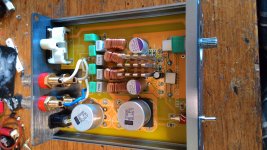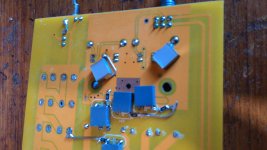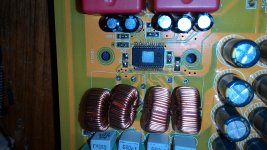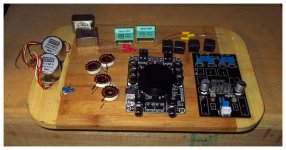Wow! A lot of uber nice builds lately! So lets continue on with the eyecandy
I received my el cheapo hifi 2.0 last week and now its almost ready! It sounds really good! I performed listenening test between each mod to get a deeper understanding of the changes. I started with the large Panasonic FK (low esr and cheap in 3300uF). They helped at lot on noise level and some on dynamics. But I guess they were too far from the chip to really make a difference. Later I added the usual oscon soldered onto the chip legs.. Huge improvement! Just as described in earlier postings!
When I added the snubber the harsness on vocals went away! The amp can't sound good with out the snubber mod.
The bootstaps were films from the factory and the amp didn't sound compressed when played loud, so I let them be.
At this point the sound didn't quite have that magic sparkle.. so I changed the input caps to my usuall trusted PPS 1uf smd caps. I am going to solder more in paralell to get atleast up to 2-3uF. That lowered the standby noise to a minimum as well giving the amp the last bit of sparkle and realism! I guess the noise has something to do with them being soldered flat on the pcb close to the ground layer.
This particular board has toroids as inductors and is the only board that plays strings perfect. So I will add toroids of better and larger inductors to my other boards as well
The build quality on this hifi amp is really amazing! Even better it costs only 38 usd! Machined alu front plate and knob. Mute knob and screw terminals on the back(too small). 8 screws holds it together and it's really quick to dismantle. The board has good space between the components with trough holes. Perfect for diy! As long as the RC snubber is used the extra distance doesn't matter all that much. I'll add some detailed pics for anyone one who wants to go this route
Other positive things I've noticed with this board:
+wide traces on the power side and output.
+nice bootstraps
+space under the pcb to add smd components
+usable inductors
+space which allows normal size input caps
+space for psu filter caps(with large trough holes)
+large rubber feet
+really good brushed case finish
I received my el cheapo hifi 2.0 last week and now its almost ready! It sounds really good! I performed listenening test between each mod to get a deeper understanding of the changes. I started with the large Panasonic FK (low esr and cheap in 3300uF). They helped at lot on noise level and some on dynamics. But I guess they were too far from the chip to really make a difference. Later I added the usual oscon soldered onto the chip legs.. Huge improvement! Just as described in earlier postings!
When I added the snubber the harsness on vocals went away! The amp can't sound good with out the snubber mod.
The bootstaps were films from the factory and the amp didn't sound compressed when played loud, so I let them be.
At this point the sound didn't quite have that magic sparkle.. so I changed the input caps to my usuall trusted PPS 1uf smd caps. I am going to solder more in paralell to get atleast up to 2-3uF. That lowered the standby noise to a minimum as well giving the amp the last bit of sparkle and realism! I guess the noise has something to do with them being soldered flat on the pcb close to the ground layer.
This particular board has toroids as inductors and is the only board that plays strings perfect. So I will add toroids of better and larger inductors to my other boards as well
The build quality on this hifi amp is really amazing! Even better it costs only 38 usd! Machined alu front plate and knob. Mute knob and screw terminals on the back(too small). 8 screws holds it together and it's really quick to dismantle. The board has good space between the components with trough holes. Perfect for diy! As long as the RC snubber is used the extra distance doesn't matter all that much. I'll add some detailed pics for anyone one who wants to go this route
Other positive things I've noticed with this board:
+wide traces on the power side and output.
+nice bootstraps
+space under the pcb to add smd components
+usable inductors
+space which allows normal size input caps
+space for psu filter caps(with large trough holes)
+large rubber feet
+really good brushed case finish
Attachments
dboy, I think you might be on to something! As mentioned earlier my rDac does not have an ounce of dynamics with higher impedance amps(60K+) It plays best at 15k and above. I like having my tpa3116 boards at 32db gain (lower imp.) and larger value input caps. But using a transformer is probably a better solution..
Impulse60,
Thanks for telling us about this board. It reminds me a lot of a 2.0 version of the Breeze Audio 2.1 with case and all. I am glad the snubber mod is working out for you and you think it helps substantially. Rhing's OSCON tip and the snubbers seem to me to be the critical mods. I am still on the fence of input caps have huge effect. My next test will be input transformers. Those FK's look like a great low profile option - I will have to look into that for the power supply input pin cap.
Thanks for telling us about this board. It reminds me a lot of a 2.0 version of the Breeze Audio 2.1 with case and all. I am glad the snubber mod is working out for you and you think it helps substantially. Rhing's OSCON tip and the snubbers seem to me to be the critical mods. I am still on the fence of input caps have huge effect. My next test will be input transformers. Those FK's look like a great low profile option - I will have to look into that for the power supply input pin cap.
Rhing, thanks for the pics and report. I know you've had many tpa311x amps in your hands. Is it safe to conclude that this one (with the trafos) is now the hands-down best? (Speaking only of tpa311x amps of course. Although a related question is, how does this latest rank overall of all amps you've ever heard?)
Another question: did you wire the xformer up to support balanced inputs?
Thanks again, although I'm a little miffed because, even though I haven't ordered them yet, my wallet already feels $120 lighter! You may get a call from my wife.
Even though I have built a few TPA31xx amps, I haven't tried all of them, so I wouldn't want to say one is better than the other. I can say that the YJ blue amp with the CineMag transformers is very impressive. I was only able to go through three albums last night before calling it quits. Once I get off work this evening, I'll be back in the man cave spinning discs again. A couple audio friends may come by over the weekend to audition the amp. I like to rely on my friends' feedback, because I can get an honest, unbiased opinion on the sound of my system. Most of my friends are music lovers first, and some don't even do the DIY audio thing. In my last audio get together, they really liked the modified YJ before the input transformers and 4x 2,200uF/25V Panasonic FM caps were added. The Dynakit Stereo 35 won the shootout, but by a small margin.
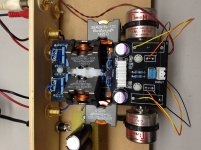
The CineMags are wired to balance the unbalanced inputs, so:
Primary windings:
- RED leads are connected to signal inputs on the RCA connectors
- BROWN leads are connected to the grounds on the RCA connectors
Secondary windings:
- YELLOW (HI) leads are connected to the LINP and RINP inputs
- ORANGE (LO)leads are connected to the LINN and RINN inputs
- BLACK leads are connected to the signal grounds on the amp board
The CineMag CMLI-15/15B are shielded in a mu-metal case, but I did not have to connect the WHITE shielding leads to earth or chassis ground. There is no hum issue.
I didn't add any caps or resistors. It's a pretty straight-forward connection. I did buy some Vishay-Dale RN55 resistors for this just in case. I tried 15k and 30k wired in parallel to the amp inputs, and the amp sounded better without them. 15k:15k seems to work well with the 26dB gain setting (30k input impedance). Great tonal balance and excellent bass definition--gave me goose bumps when I listened to the end of "Saturn" from Holst's "The Planets" performed by Herbert von Karajan and the Vienna Philharmonic.

If you're miffed, I'm miffed, because I should've bought the Lundahl LL1690's instead. Maybe I'll get those next and try them on my Sure TPA3116.
Last edited:
..... Now back to the Class D fun, I finally wired up the CineMag CMLI-15/15B input transformers to my modded YJ blue amp. Keep in mind this is a temporary test bed build, and I will tidy up the wiring, but those little silver cylinders were talking to me to install them since they arrived two days ago.
Originally, I was going to do the bootstrap snubber mod, but I decided to do this first. I will get around to doing the snubber mod, so don't flame me. I spent $120 on these things, so I was going for the big buck mod first.
All I can say is this amp sounds pretty awesome playing Patricia Barber's "Cafe Blue." Just as dboy and sharp31 have previously reported, the input balancing transformers really open up the amp. The sound is definitely clearer with some incredible inner detail. The soundstage is substantially larger and the bass is punchier and more articulate. This is noticeable on kick drum strikes. If you want air, the transformers will give it to you.
Looks like I have a weekend project or two ahead of me.
Excellent work rhing!
.
Attachments
Looks like I have a weekend project or two ahead of me.
Excellent work rhing!
.
Cannot wait to hear your comments on the Sure board which is already very good in its stock form.
Sent from my iPhone using Tapatalk
so I changed the input caps to my usuall trusted PPS 1uf smd caps. I am going to solder more in paralell to get atleast up to 2-3uF. That lowered the standby noise to a minimum as well giving the amp the last bit of sparkle and realism!
That doesn't work that way. Let's say you have a 1uf capacitor, and a corner frequency of 35hz. Now you put in a second. That's 2uf, but the amp will see it like a .5uf for corner frequency so now you've got 43hz corner frequency or whatever. Those aren't exact corner frequencies, but that's how it works with input signal capacitors.
If you want 2uf you need two 4uf capacitors. It's a problem of ESR, not uf.
That doesn't work that way. Let's say you have a 1uf capacitor, and a corner frequency of 35hz. Now you put in a second. That's 2uf, but the amp will see it like a .5uf for corner frequency so now you've got 43hz corner frequency or whatever. Those aren't exact corner frequencies, but that's how it works with input signal capacitors.
If you want 2uf you need two 4uf capacitors. It's a problem of ESR, not uf.
Impuls60 is correct - caps in parallel do add together in terms of capacitance, reducing the corner frequency. You'd be right if he'd said that he'd add the other caps in series.
It's a problem of ESR, not uf.
It's f = 1/(2pi*R*C) so actually ESR has nothing to do with it.
/U.
Input transformer?
Could I get somebody to look at this and tell me if suitable as input trafo for the 3116 please? If suitable how to wire up.
Bought as an output trafo for a DAC from fellow DIYAUDIOer, this was said about them:
"They are 1:1 ratio but deigned to be driven from a source of about 100-200 ohms into a load of about 10K or more. Typical of a voltage out DAC into a preamp or power amp.
DCR is about 50R. But that is NOT the impedance seen by the load - except at DC. At anything about 15Hz, the source will see the approx. the impedance on the secondary."
Could I get somebody to look at this and tell me if suitable as input trafo for the 3116 please? If suitable how to wire up.
Bought as an output trafo for a DAC from fellow DIYAUDIOer, this was said about them:
"They are 1:1 ratio but deigned to be driven from a source of about 100-200 ohms into a load of about 10K or more. Typical of a voltage out DAC into a preamp or power amp.
DCR is about 50R. But that is NOT the impedance seen by the load - except at DC. At anything about 15Hz, the source will see the approx. the impedance on the secondary."
Attachments
Last edited:
Impuls60 is correct - caps in parallel do add together in terms of capacitance, reducing the corner frequency. You'd be right if he'd said that he'd add the other caps in series.
Really? Let me ask you something.... Do you think the preamp/volume/source will view each capacitor as having 60kohm or 30kohm of ESR with the TPA3116 at the stock gain? Now calculate corner frequency again.
I know the equation above - that is what determines the RC time constant and hence freq response. The R there is impedance of the amp input. The capacitor ESR is not the source of the voltage drain in this case (related to RC time constant of system) but determines how fast current can discharge from the capacitor. That is why low ESR OSCON's can give more deep bass punch - they have higher transient current capability because of low ESR. This has nothing to do with the discharge RC time constant that controls the bass extension on the amp input.
With reference to the above discussion, I have a question on parallel decoupling caps.
I have ordered the wrong value of Wima MKP caps - 0.68uf instead of the minimum 1.0uf. Now, I am planning to try 3 x 0.68uf in parallel for approx 2.2uf (if space permits), or at least 2 x 0.68uf in parallel.
Any potential issues with this approach?
I have ordered the wrong value of Wima MKP caps - 0.68uf instead of the minimum 1.0uf. Now, I am planning to try 3 x 0.68uf in parallel for approx 2.2uf (if space permits), or at least 2 x 0.68uf in parallel.
Any potential issues with this approach?
The pcm5102a can be used without dc blocking caps. Can i connect this dac chip to the tpa3116 without dc blocking caps? ( i only use the tpa3116 with an usb dac )
There needs to be one set of coupling caps between the PCM5102A outputs and TPA3116 inputs, as the two are at a different potential. You could of course use a transformer instead of the coupling caps.
Really? Let me ask you something.... Do you think the preamp/volume/source will view each capacitor as having 60kohm or 30kohm of ESR with the TPA3116 at the stock gain? Now calculate corner frequency again.
The source will only see the impedance of the input of the amplifier in series with the impedance of the cap (or parallel cap array) at any give frequency. The relative impedance of the cap and amp input at a given frequency will determine how much voltage exists across each, and this will determine LF roll-off (as frequency reduces and more voltage develops over the cap, less exists over the amp input). Cap ESR is trivial given the far higher series impedances in the system.
Could I get somebody to look at this and tell me if suitable as input trafo for the 3116 please? If suitable how to wire up.
Bought as an output trafo for a DAC from fellow DIYAUDIOer, this was said about them:
"They are 1:1 ratio but deigned to be driven from a source of about 100-200 ohms into a load of about 10K or more. Typical of a voltage out DAC into a preamp or power amp.
DCR is about 50R. But that is NOT the impedance seen by the load - except at DC. At anything about 15Hz, the source will see the approx. the impedance on the secondary."
It isn't text book perfect for the application, but should work very well. Go for it!
- Home
- Amplifiers
- Class D
- TPA3116D2 Amp
